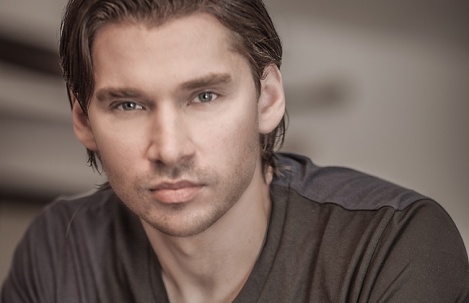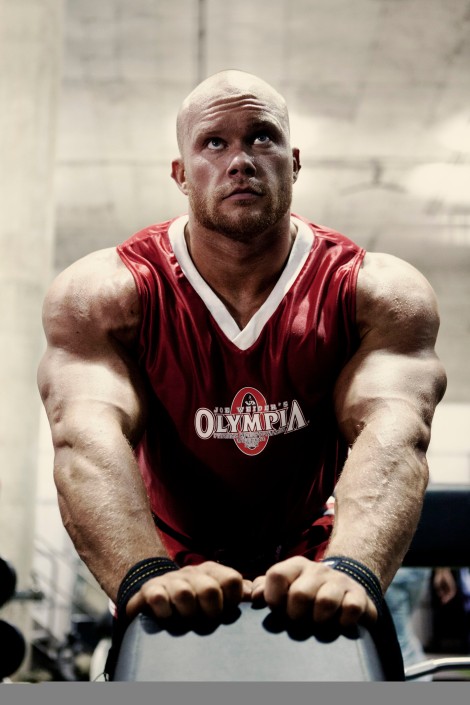
Vlad Yudin is a writer, director and a principal producing partner of The Vladar Company. His newest documentary, Generation Iron, follows seven professional bodybuilders on their journeys to the 2012 Mr. Olympia competition. Released theatrically on September 20, 2013, and currently touring the international theatrical circuit, Generation Iron features appearances by such fitness royalty as Phil Heath, Kai Greene, Lou Ferrigno, Michael Jai White, Ronnie Coleman, and Arnold Schwarzenegger. Vlad Yudin spoke with Sean Malin of CineMalin: Film Commentary and Criticism to discuss the artistry of athleticism, working with narrator Mickey Rourke, and his search for objectivity in documentary. This interview has been transcribed, edited, and compressed from audio for publication.
*****
Sean Malin: It seems to me that bodybuilding is still somewhat peripheral in the United States. Where did your interest in the sport begin?
Vlad Yudin: I’ve always been exposed to fitness and the need to go to the gym, obviously. But the inspiration for this film wasn’t the gym or fitness – it was the idea of what the professionals actually do. Professional bodybuilding is a very misunderstood sport. Even though there’s a huge audience that loves it, I was shocked when I started the project to find how many people disliked it. I think that’s because people don’t realize how much goes into it as a career or as these athletes’ art. They have to envision their bodies a certain way, and then to achieve that.
SM: In Generation Iron, Arnold Schwarzenegger describes the work of these professionals just as you do: as an art form. But we don’t think of them as artists or creatives.
VY: To get the kinds of physiques they have, you have to build to a certain size level and to pose a certain way when you work out. This is a casting process, like sculpture. You have to factor your genetic capabilities into how far you can push yourself, sure, but this is an everyday process of tweaking and growing. The mental process is fascinating, too, because the day before they compete [in Mr. Olympia], they lose a lot on their bodies just to stress. What mental pressures can do to your body and how well you perceive competitors as having been received can play a huge part on your confidence.
SM: Your film features a lot of the characters trash-talking and verbally brutalizing one another before, during, and after competitions. Does this sort of animosity between the athletes play a part in the taboo nature of bodybuilding?
VY: No, I think this [trash-talk] is in professional fitness in general. In boxing, for example, there’s a lot more of it; but people like it, you know? Everyone loves a good rivalry and the kinds of heated moments between people where you just don’t know what’s going to happen. To my eye, the taboo comes from the body-types, which typically scare people. If you accidentally find a bodybuilder on television, for example, he’s inevitably at the gym or working out or competing. I think this film shows them as people, which we’re not used to. We don’t know their stories – all we’re shown is that these guys are meatheads. I called it “misunderstood,” earlier, but it’s not even, because you have to be exposed to something enough to think you can understand it. People are not used to being exposed to the stories.
SM: A lot of time has passed since Pumping Iron brought bodybuilders into the mainstream media, and you are particularly attentive to the changes in technology since 1977. How extensive was the research and production prep for your movie?
VY: Oh, quite extensive. I wanted to get to know the guys and for them to know me so we could create a certain level of trust. Showing up at someone’s house with full camera crew and sound people can easily turn into a situation where you get shut down. I went to many small [fitness] shows and spent a lot of time discussing the vision for this project. Working with a newcomer like Ben Pakulski and the Japanese competitor Hidetada Yamagishi, there’s a huge challenge to tell all their stories. But by spending so much time researching and shooting with them, we started to get a sense of bodybuilding as a whole, and I think that comes through in the film.

SM: Some of your subjects – Phil Heath, Kai Greene, Ferrigno – are the most famous professionals in their field. They are inundated with press attention, flashing cameras, and media requests. How did the athletes feel about you and the shooting process?
VY: It took a lot of conversation *laughs*. A lot of clearances, and a lot of travel. I’m not a bodybuilder, but I felt that would work to my advantage because I see some things about the business that people in the business might not necessarily notice, and I mentioned this. A good example of something they don’t really think about – because they go through it every day – is the tanning process. Tanning is maybe the only thing that every competitor must do to be on that stage. You need a thick coat from a spray-tanner. For the athletes, this is nothing, but it was fascinating for me to film these guys going through layers and layers of [tanning product.] It’s an incredible sight: huge men lining up for these oils and sprays. But if I were a bodybuilder professionally, this would get overlooked.
SM: I can’t even imagine how long it takes for seven different characters to open up to being on camera…
VY: We spent two months in primary production and then went on to quite a few pickup shoots. We shot in Europe [Roelly Winklaar is based in the Netherlands], Pittsburgh, Las Vegas – anywhere these guys lived or where there were little shows. But all this, even with editing and getting Generation Iron to theaters, took about a year – so not a bad turnaround.
SM: The result of your extensive conversations with them is an unprecedented level of access to their family lives, as well as to the Mr. Olympia 2012 competition in Las Vegas, NV. You explore scientific experiments with Mr. Pakulski at a university in Miami; you have some footage of Winklaar in a competition in Lathi, Finland. Were they at all concerned with your interest in objectivity?
VY: I told all the guys before we started and all the organizations that gave us behind-the-scenes access that this was going to be an honest film. That means we have to talk about everything that’s important. I wanted to be respectful, but you can’t make a film that promotes the sport.
SM: You would not be taken seriously if you avoided the subject of steroid use, for example.
VY: Absolutely – and the organizers of Olympia and the other shows knew how important that was [for the film.] I had a long conversation with Jerome Gary, our executive producer and the producer of Pumping Iron, on this subject. Ultimately they did grant us the access and you can see [in scenes where they discuss steroids] that the bodybuilders believed in the piece as well.
SM: Linking the entire film together is an emotional voiceover from Mickey Rourke, a professional actor. Did that require a more traditional kind of writing and directing to make it gel with the movie? How involved was he in his VO performance?
VY: I had always intended on a voiceover to add that third dimension to the film, and Mickey Rourke was never anything but my number one choice. First of all, what an amazing voice! Also, he’s the type of guy who is respected by cinephiles and audiences who like movies-as-art as much as by the fitness community. He’s had a lot of physical roles in his career – even though The Wrestler (Aronofksy, 2008) was about a completely different sport, there’s a strong influence on how natural he is [here.] When we were talking about the narration, I found out his father used to bodybuild in New York, so he had a real relationship to these guys. In my opinion, what comes through in his voice helps the film to come alive. You can hear some of the pain these guys go through, and their anxiety and pressure, just in his voice – he manages to transfer that to the screen.
SM: Since you spent so much time with a large group of people, did any of them stop being your subjects and start becoming real friends?
VY: Even though I left filming with a lot of feelings for these guys, I wanted to be objective [as a filmmaker.] There was no chance of becoming best friends with any of them because who knew if they’d say, “Why did you show this, why did you show that?” My main concern was with the audience watching the film. I think I had to be objective, and that’s getting through to people inside and outside the bodybuilding community. Most people don’t expect to see how deep these guys are, but you have to give them a platform to talk openly.

Editor’s Note: Still images graciously provided by Integrated PR.

Amazing interview. Really interesting to this of body building as an art form. Maybe LA Fitness can publish your interview in the program booklet or use the video somehow